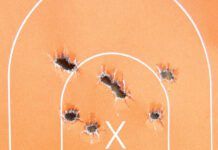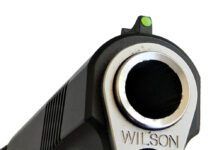The use of the word “basic” in describing pistols in this test would shock pistol shooters from less than a decade ago. When it comes to the 1911 .45, what passes for standard equipment has improved dramatically. All three of the guns in this test share the same design and are the lowest-priced models available from their respective manufacturers, but they are by no means “basic” guns, at least not in historical terms.
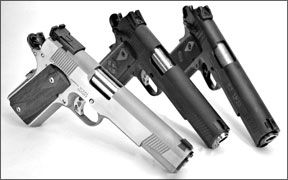
We recently got and shot the $904 Springfield Armory Parkerized w/Night Sights PX9109L, CZ USAs $1079 Dan Wesson Pointman Seven 01900, and one of the lowest-priced 1911s weve encountered, the $617 Taurus PT1911 1-191101.
Here is a list of features shared by the test pistols that not long ago were upgrades that were only available from the hands of a custom gunsmith: Beginning at the muzzle we found full-length guide rods, dovetailed-mounted front and rear sights, forward cocking serrations, flared ejection ports, reduced mass hammers, relieved-mass triggers adjustable for overtravel, a wide beavertail grip safety with raised contact area, checkered mainspring housing, checkered grips held in place by Allen screws, and a beveled magazine well.
Elsewhere, there were some differences worth noting: The Dan Wesson Pointman had a stainless-steel finish and a BoMar-style adjustable rear sight. The Taurus pistol was blued, and the Springfield model was Parkerized. The latter two pistols offered a low-mount rear sight, windage adjustable by drift only. They also came with ambidextrous thumb safeties. The Dan Wesson thumb safety was left side only.
How We Tested
We began our test session by thoroughly lubricating each pistol with Break Free. Then we shot the guns at Houstons Top Gun Range (topgunrange.com), firing from a sandbag rest at targets placed 15 yards downrange.
Our test rounds consisted of 230-grain and 185-grain JHP ammunition from Black Hills plus a popular target round, the Winchester USA 185-grain FMJ load. Also, we loaded our own rounds. Atop fresh Winchester cases and a dose of Hodgdon Clays powder, sparked by Winchester large pistol primers, we seated 230-grain roundnose flat-point bullets from Precision Bullets (precisionbullets.com).
We chose this hard-swaged (certified 6/2), lead-alloy slug because its sizing was impeccable, and it featured a dry-lube coating that completely encased the lead. Not only did this coating make the bullets safer and cleaner to handle, but the lack of exposed lead made it acceptable for indoor shooting. Here is what we found.
Taurus PT1911 1-191101
.45 ACP, $617
With its low price tag and long list of features, the PT1911 has been flying off dealers shelves. Our test sample was nearly black, though the finish is officially listed as blued on the taurususa.com website. The PT1911 had checkering front and rear and classic checkered grip panels. The hammer was not skeletonized in the same way as the Springfield or Dan Wesson products, which offered a wide open loop. But the Taurus hammer performed one other job in addition to pounding the firing pin.
Inside the forward mass of the hammer was a key-operated lock that, when activated by one of the two supplied keys, prevented the hammer from being pulled back. The lock can be turned with the hammer back, but this will not prevent the hammer from moving forward and striking the firing pin. Locking the gun with the hammer down over an empty chamber is the proper way to make use of this feature.
The sights were designed by one of the legendary names in 1911 gunsmithing, Richard Heinie. But the version of Heinies Straight Eight sights used on the Taurus pistols is exclusive to Taurus and not available from Brownells or from Heinie Specialty Products of Quincy, Illinois, (heinie.com). The name of the sight system was derived from the visual format that asked the shooter to place the dot found in the front sight directly over the single dot below the center of the notch in the rear unit. The two circles placed one above the other creates the numeral eight. This is intended for low-light situations, especially with tritium dots in place. But these sights can still be used in the traditional manner by centering the front blade inside the rear notch. The Taurus version of this sight provided large gaps between the front blade and the inside edges of the rear sight. Members of our test staff liked the sight, but from the bench we felt the sight picture was too coarse for fine accuracy.
The guide rod found on the PT1911 was a full-length design, but short enough so that a bushing wrench could depress the spring plug. Some of the more determined operators on our staff were able to compress the spring and turn the bushing without using a wrench.
When we shot the Taurus PT1911, two characteristics were immediately apparent.
First, the gun delivered hits that were between 2.0 and 2.5 inches below our point of aim at 15 yards. Second, the front sight seemed to be mounted slightly off center, causing us to aim a little to the right on our plate rack.
Elsewhere, the trigger broke cleanly. We felt the Taurus recoiled more than the other pistols. This could be caused by a number of reasons, beginning with the grip not sealing entirely against the hand or a sloppy slide-to-frame fit. The Taurus was tight top to bottom, however, and we all liked the grip, so we left that mystery to be solved later.
During our bench test we experienced two problems. The first problem came when a round in the middle of a string exploded with much greater force and flash than previous rounds of Winchester 185-grain FMJ ammunition. We chalked it up to an overcharged round and continued with caution. Over the course of our tests with the factory ammunition, we experienced about a 6 percent failure to feed. Stoppages showed a loaded round halfway out of the magazine.
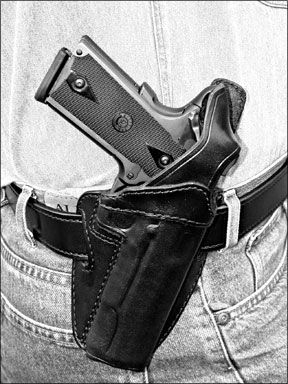
Made in Brazil, the Taurus supplied magazines with eight rounds featuring a counting hole for each round, a wide flat follower, and a removable base pad. Not able to find anything wrong with the pistol that would account for the failures, we tried seven-round magazines supplied with the Springfield Armory and Dan Wesson pistols, (which were identical except for the Dan Wesson logo), plus some eight-round magazines produced by Wilson Combat, (wilsoncombat.com). Each one of these magazines performed flawlessly with our test ammunition.
So we continued our accuracy tests using the Springfield Armory/Dan Wesson magazines. Immediately, our groups improved in some cases by more than one inch. We proceeded to retest all of our factory ammunition using the seven-round magazines, the results of which are displayed after the slash mark on our accuracy chart. Not sure why the Taurus was now performing more accurately, we contacted master gunsmith Ross Carter (rosscarter@cox.net). The discussion of how a change in magazine could improve accuracy was in low gear until we mentioned that we had nearly suffered a “ka-boom,” or overcharged factory round. Carter said that it is not impossible to come across overloaded factory ammunition, but it was very unlikely.
Instead, considering the failures to feed as well, Carter formed the following hypothesis.
The feeding of the .45 caliber round in a single-stack 1911 requires that the fresh round bump against the feed ramp and skip upward into the chamber. This is why a 0.030-inch gap is called for between the edge of the frame and the edge of the barrel throat, unless it is an integral ramp barrel
. If the magazine impedes the round in any way, such as launching the round from a difficult angle, the bump-and-skip process may cause too heavy a blow to the nose of the bullet, causing the bullet to be pushed back into the case (set back).
Set back can often be seen in concealed carry pistols that are loaded and unloaded repeatedly with the same rounds. After a few cycles you can usually see that the bullet in the top round has been significantly set back. The best advice is to not use the same round first each time you load the weapon and to discard any rounds that have bullets set back.
The increase in pressure from bullet set back can be dangerous. At the very least a series of rounds suffering different degrees of setback would create a wide range of pressures launching each bullet at a different velocity and therefore, delivering a different point of impact. This is why we think the more precise fitting magazines supplied with our other two pistols helped the Taurus land better groups. In addition, we think the variation in velocity may have contributed to our perception of the Taurus as transmitting more recoil to the shooter.
Final results with proper magazines in place were acceptable for 15 yards, but the Taurus still trailed behind the Springfield and Dan Wesson pistols with the factory ammunition. However, we were able to edge out the PT1911s competitors by landing 1.6-inch groups on average, firing our ammunition hand-loaded with the Precision bullets.
Springfield Armory
Parkerized w/Night Sights
PX9109L .45 ACP, $904
With the exception of Novak night sights and perhaps the wood grips, Springfield Armorys model PX9109L (L for internal lock) appears to be a base-model 1911. Even the manufacturer uses the term Standard in its catalog description. But hidden in the shadows of its dark Parkerized finish were features that made it special. All we could think to add to this pistol was a low-profile magazine guide and checkering on the front and the back of the grip frame.
This pistol also has an integral locking system that freezes the mainspring, but unlike on the Taurus, the lock can only be turned with the hammer down.
The PX9109L felt heavier and larger in our hands, but weight and size were nearly identical among all three guns. Grip circumference was the largest by only 0.1 inch more than the Dan Wesson and 0.2 inch more than the Taurus. The Springfield and Dan Wesson pistols came with grips that were fatter than the Taurus, and they gave the shooter the impression the front strap of these pistols was more narrow. Overall, the Springfield had a very solid feel in the hand almost like it was a single block of steel.
Some of our staffers complained about how far they had to shift the Springfield in their hands to activate the magazine release. We would like to see this model offered with the same grips as Springfields 2007 TRP and PX9152LP pistols. These grips have a bevel on the left side panel that guides the thumb to the magazine release.
The full-length guide rod was actually two pieces, and the difference was most evident when removing the top end. Step one is to drop the magazine and clear the chamber. Then, lock back the slide. A 5/32-inch Allen wrench (supplied) was used to loosen the forward section of the guide rod. With the slide released to its normal rearward position, the guide rod was unscrewed and pulled out. Now the bushing could be rotated and the spring cap removed carrying on with the normal field stripping process. Upon reassembly, tightening the guide rod was best performed with the slide locked back to prevent misalignment.
At the range we found that the sights of the Springfield Armory PX9109L were dead on firing the 185-grain ammunition. Several groups measured about 1 inch across at 15 yards. Final averages firing our two 185-grain rounds told us that we could expect 1.5-inch groups at this distance. Groups fired with both our 230-grain rounds, including our handload featuring Precision bullets, averaged between 1.5 and 2.0 inches across.
Dan Wesson Pointman Seven
.45 ACP 01900, $1079
The Pointman Seven is one of three 1911s offered by CZ-USA under the name Dan Wesson. Its stablemates are a Commander-sized pistol with 4.25-inch barrel and bobbed mainspring housing, plus the RZ-10 chambered for 10mm ammunition.
The Pointman Seven was the only stainless-steel pistol in our trio, and its finish offered two different looks. The sides of both the receiver and the slide showed a brushed finish. The top of the slide was finished with a matte or frosted surface. So were the front strap and the undersides of the trigger guard and dustcover. The magazine well of the Pointman was not beveled as deeply as either the Taurus or Springfield pistols.
But the Dan Wesson did one-up these two guns with the addition of a Bo-Mar style adjustable rear sight. The front was a target blade with horizontal serrations to cut glare.
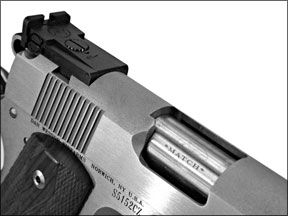
The Pointman did not offer an ambidextrous thumb safety nor did it have an integral locking system. This was prohibitive for the left-handed shooter and tacticians who want to control the gun with either hand. The full-length guide rod was short enough so that the spring plug can be depressed even with the gun in full battery. Due to the tight fit of the barrel bushing, a wrench (supplied) was necessary for field stripping.
Measuring straight back from the center of the triggers, all three guns registered a trigger span of 2.7 inches. Holding the Pointman in our hands, some of our staff was able to obtain a more comfortable index on the trigger than on the larger-feeling Springfield. This meant the pad of the index finger centered comfortably on the face of the highly skeletonized aluminum trigger. Trigger pull weight was 4 pounds, 30 percent lighter than its competitors. This may be why the Dan Wesson came out on top in our accuracy tests.
Then again, without tritium modules or white dots, the target sights might have made the biggest difference. Not only did we print sub-1- inch groups with each choice of factory ammunition, but we very nearly placed all five shots of Black Hills 185-grain JHP into one hole 0.5 inches for the cloverleaf pattern, using the hardest hitting of our defense rounds.
Using our handload, we learned that when attempting to chamber the Precision bullets, the slide would not completely close. We found that the Precision bullet was too wide at the front and was bumping against the rifling just ahead of the chamber. In comparing the transition from the chamber to the rifled area of the barrel, we found that the lead-in was shorter than most pistols.
We contacted CZ-USA, and they told us that this was on purpose. Indeed, many believe that the amount of time a bullet stays in an unrifled area directly affects accuracy. Did this mean that reloaders are prohibited from firing economical lead bullets in Dan Wesson pistols? No. We merely switched to a bullet that featured a thinner tip and a wide shoulder. Precisions semi-wadcutter bullet would be ideal in this case, but for comparison sake we dug out some 230-grain RNL bullets from a classic H&G pattern mold and had no problem sending lead down range. Groups measured about 1.7 inches across, on average.
Dan Wesson Pointman Seven
01900, 45 ACP, $1079
Dan Wesson is a name most closely associated with revolvers. But under the banner of CZ-USA, the Pointman Seven should make a name for Dan Wesson among 1911 manufacturers. Superb accuracy. Great trigger and nice Bo-Mar style rear sight. Downside: Some shooters wont like the left-side-only safety.
Gun Tests Grade: A-
Springfield Armory Parkerized
w/Night Sights PX9109L
.45 ACP, $904
The PX9109L fed every type of bullet we could find. The night sights were low profile and compact. What we liked best about this pistol was that it was very consistent and predictable in terms of its accuracy and felt recoil. Ding: Some of our staffers complained about how far they had to shift the Springfield in their hands to activate the magazine release.
Gun Tests Grade: B+
Taurus PT1911 1-191101
.45 ACP, $617
On the positive side, the Taurus PT1911 offers a lot of value for what is typically a $560 counter price. But ours needed to be sighted in, and we wanted better-quality magazines.
Gun Tests Grade: D



